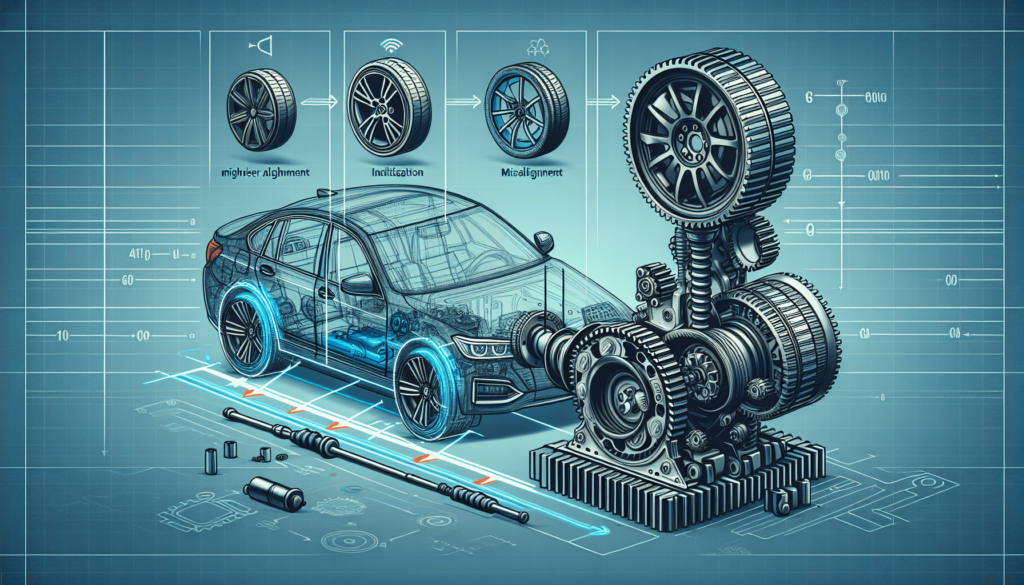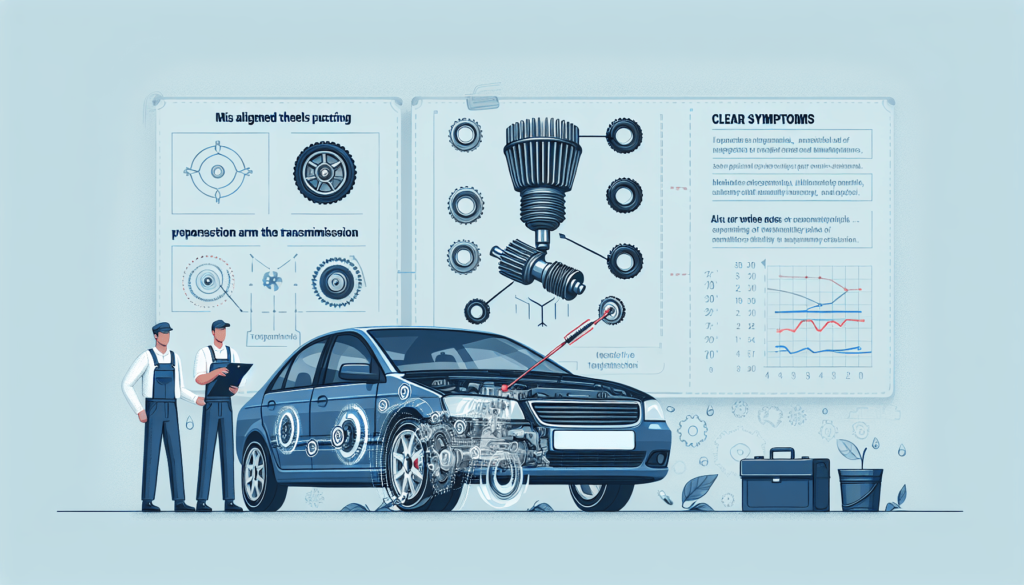Imagine driving down the road, feeling the smoothness of the ride as you effortlessly glide along. Suddenly, you notice a slight pull to one side, and the steering wheel becomes harder to control. Frustrated, you wonder what could be causing this sensation. Surprisingly, the answer may lie in the alignment of your wheels. Yes, you heard it right – the alignment of your wheels can have a direct impact on your vehicle’s transmission system. In this article, we will explore the fascinating relationship between wheel alignment and the transmission system and uncover how a simple adjustment can make all the difference in your driving experience.
Definition of Wheel Alignment
Explanation of wheel alignment
Wheel alignment, also known as tire alignment, refers to the precise adjustment of the angles and positions of the wheels on a vehicle. It is a crucial aspect of vehicle maintenance that ensures the wheels are aligned correctly with each other and with the vehicle’s body. Proper wheel alignment helps optimize the performance, handling, and safety of a vehicle.
Importance of proper wheel alignment
Maintaining proper wheel alignment is essential for several reasons. Firstly, it ensures even tire wear, prolonging the lifespan of the tires and reducing the need for premature replacements. Secondly, it enhances the vehicle’s handling and maneuverability, delivering a smoother and safer driving experience. Thirdly, proper wheel alignment helps maximize fuel efficiency by minimizing rolling resistance and reducing drag. Lastly, it plays a significant role in preserving the overall health and performance of the transmission system.
Understanding the Transmission System
Overview of the transmission system
The transmission system is a vital component of a vehicle responsible for transmitting power from the engine to the wheels. It allows for smooth and efficient shifting of gears to match the engine’s output with the desired speed and torque requirements. The transmission system consists of various intricate mechanical and hydraulic components, working in tandem to optimize power delivery and vehicle performance.
Components involved in the transmission system
The transmission system comprises several key components, including the transmission itself, torque converter, clutch, gear selector, and driveshaft. The transmission serves as the central unit responsible for gear engagement and disengagement, providing multiple gear ratios to accommodate different driving conditions. The torque converter acts as a fluid coupling device, transmitting engine power to the transmission. The clutch facilitates the engagement and disengagement of power between the engine and transmission, enabling smooth gear changes. The gear selector allows the driver to choose the desired gear ratio, while the driveshaft transfers power from the transmission to the wheels.
Functions of the transmission system
The primary function of the transmission system is to convert and transmit power from the engine to the wheels, ensuring optimal vehicle performance. It achieves this by providing different gear ratios to match the engine’s output with the desired speed and torque requirements. The transmission system also facilitates smooth gear changes, allowing the vehicle to accelerate, decelerate, and maintain a steady speed efficiently. Additionally, it enables the vehicle to reverse by engaging the reverse gear, enhancing overall drivability and maneuverability.

The Impact of Wheel Alignment on the Transmission System
Correct alignment and its effect on transmission
Proper wheel alignment significantly influences the performance and longevity of the transmission system. When the wheels are correctly aligned, the vehicle moves straight, minimizing stress on the transmission components. This promotes smoother gear engagements and reduces unnecessary wear and tear on the transmission gears, clutches, and other vital parts. Correct alignment ensures that power is efficiently transmitted from the engine to the wheels, optimizing overall transmission performance.
Misalignment and its consequences on transmission
On the other hand, when the wheels are misaligned, numerous negative effects can occur within the transmission system. Misalignment places uneven stress on the transmission gears, leading to increased friction, premature wear, and potential damage. The gears may not properly engage or disengage, resulting in jerky gear shifts and reduced overall performance. Excessive misalignment can also cause misalignment within the drive shaft, further compromising the transmission’s efficiency and reliability.
Signs of misalignment affecting the transmission
There are several signs that indicate misalignment is affecting the transmission system. One common symptom is rough or hesitant gear shifting, where gears may grind or slip unexpectedly. Another sign is a noticeable decrease in acceleration and overall performance, as the transmission struggles to transmit power efficiently. Additionally, misalignment may cause unusual noises, such as clunking or whining sounds, when shifting gears or during normal driving. It is essential to address these signs promptly to prevent further damage to the transmission system.
Alignment-Related Issues Affecting Transmission
Uneven tire wear
Misalignment often leads to uneven tire wear, where certain areas of the tire tread experience excessive wear compared to others. This uneven wear pattern puts added strain on the transmission system, as the tires no longer maintain optimal contact with the road surface. The transmission may face increased resistance and unnecessary stress, impacting its overall performance and longevity. Regular wheel alignment helps minimize uneven tire wear, reducing the risk of transmission-related issues.
Increased friction and heat
Misalignment can also increase friction between the tires and the road surface. As the tires drag or scrub sideways due to misalignment, excessive heat is generated. This heat buildup negatively affects the transmission system by accelerating wear and increasing the likelihood of component failure. By ensuring proper wheel alignment, the amount of friction and heat generated is minimized, preserving the transmission’s integrity and efficiency.
Excessive stress on transmission parts
When the wheels are misaligned, additional stress is placed on various transmission components. This stress can lead to premature wear and potential failures within the transmission system. Misalignment places strain on gears, bearings, clutches, and other crucial parts, reducing their lifespan and compromising transmission performance. Proper alignment helps distribute the load evenly across the transmission, reducing stress on individual components and promoting longevity.

Transmission Performance and Fuel Efficiency
Proper alignment and improved transmission performance
Proper wheel alignment plays a significant role in enhancing transmission performance. When the wheels are aligned correctly, the transmission can smoothly and efficiently engage each gear without excessive resistance or strain. This results in smoother gear shifts, improved acceleration, and overall better drivability. By ensuring proper alignment, drivers can experience optimized transmission performance, maximizing the vehicle’s potential.
Impact of misalignment on fuel efficiency
Misalignment negatively affects fuel efficiency. When the wheels are misaligned, the vehicle experiences increased rolling resistance, requiring more power from the engine to maintain speed. This increased power demand leads to higher fuel consumption, reducing overall fuel efficiency. Additionally, misalignment can cause transmission-related issues that further impact fuel efficiency. By maintaining proper wheel alignment, drivers can minimize rolling resistance and improve fuel economy.
Relationship between alignment and gear shifting
Wheel alignment directly impacts gear shifting within the transmission system. Correct alignment ensures that the gears properly engage and disengage, resulting in smooth and seamless gear shifts. Misalignment, on the other hand, can interfere with gear engagement, causing rough or hesitant gear shifts. By maintaining proper wheel alignment, drivers can enjoy smoother gear shifting, enhancing the overall driving experience.
Transmission Fluid and Alignment
Role of transmission fluid in the system
Transmission fluid plays a crucial role in the transmission system. It serves as both a lubricant and a hydraulic fluid, ensuring smooth operation and reducing friction between the transmission components. Transmission fluid also helps in cooling the transmission, dissipating heat generated during operation. It is vital for preserving the integrity and functionality of the transmission system.
Effect of misalignment on transmission fluid
Misalignment can have adverse effects on the transmission fluid. The increased friction and stress caused by misaligned wheels can result in higher operating temperatures within the transmission. These elevated temperatures can degrade the transmission fluid more rapidly, reducing its lubricating properties and overall effectiveness. Proper wheel alignment minimizes excessive heat buildup and helps preserve the quality and longevity of the transmission fluid.
Fluid degradation due to misalignment
Misalignment can lead to fluid degradation within the transmission system. As the transmission operates under increased stress and temperature due to misalignment, the transmission fluid can deteriorate at a faster rate. Degraded fluid may lose its viscosity and lubrication properties, compromising the performance and longevity of the transmission. By maintaining proper wheel alignment, drivers can help prevent fluid degradation and ensure optimal transmission function.

Preventing Alignment-Related Transmission Issues
Regular wheel alignment maintenance
To prevent alignment-related transmission issues, it is crucial to regularly maintain proper wheel alignment. Drivers should adhere to the manufacturer’s recommended maintenance schedule and have their vehicle’s alignment checked periodically. Regular alignment maintenance helps identify and correct any misalignment issues promptly, minimizing the risk of transmission damage and ensuring optimal performance.
Importance of professional alignment services
Professional alignment services are essential in maintaining proper wheel alignment and preventing transmission-related issues. Certified technicians have the knowledge, expertise, and specialized equipment to accurately measure and adjust the wheel angles. They can identify any misalignment and make the necessary adjustments to ensure the wheels are aligned correctly. Professional alignment services provide peace of mind and help safeguard the transmission system from potential damage.
Alignment checks after specific events or modifications
Certain events or vehicle modifications may necessitate alignment checks to ensure proper wheel alignment and protect the transmission system. For example, after a collision or a significant impact, the wheels may become misaligned, affecting the transmission’s performance and longevity. Additionally, when modifying the suspension or installing aftermarket wheels, alignment checks are crucial to maintain proper alignment and prevent potential transmission issues. Drivers should consult a professional alignment service provider for alignment checks whenever such events or modifications occur.
Alignment and Transmission System Longevity
Alignment’s impact on transmission lifespan
Proper wheel alignment significantly contributes to the longevity of the transmission system. When the wheels are aligned correctly, the transmission operates under optimal conditions, minimizing unnecessary wear and tear on its components. By reducing stress and maintaining proper alignment, drivers can extend the lifespan of their transmission, avoiding costly repairs or premature replacements.
Reducing wear and tear through proper alignment
Misalignment places excessive strain on the transmission system, leading to increased wear and tear on various components. By maintaining proper wheel alignment, drivers can distribute the load evenly across the transmission, reducing wear on individual parts. This ensures a more balanced and efficient transmission operation, prolonging its lifespan and minimizing the risk of breakdowns or failures.
Alignment as a preventive maintenance measure
Proper wheel alignment serves as an essential preventive maintenance measure for the transmission system. Regular alignment maintenance helps identify and address any misalignment issues before they can cause significant damage to the transmission. By proactively maintaining proper alignment, drivers can prevent costly transmission repairs, extend the system’s lifespan, and enjoy enhanced performance and reliability.

Alignment Adjustment and Transmission Service
Alignment process and adjustments
The alignment process involves measuring and adjusting various angles and positions of the wheels to achieve proper alignment. During an alignment service, certified technicians use specialized equipment to measure the current alignment angles, including camber, caster, and toe. Based on these measurements, the technician makes precise adjustments to align the wheels correctly. This ensures that the wheels are parallel to each other and perpendicular to the ground, maximizing vehicle performance and minimizing transmission-related issues.
Role of alignment in transmission services
Alignment plays a vital role in transmission services. When a vehicle undergoes transmission repairs or maintenance, it is essential to consider the alignment to ensure optimal transmission performance. Misalignment can negatively impact the functionality and durability of newly replaced transmission components. By coordinating alignment with transmission services, drivers can ensure that the repaired or replaced transmission parts operate under optimal alignment, maximizing their effectiveness and longevity.
Coordinated alignment and transmission maintenance
Proper alignment and transmission maintenance should go hand in hand for optimal vehicle performance. Coordinating alignment checks and transmission services ensures that both the alignment and transmission system are in optimal condition. By addressing alignment issues and maintaining the transmission system concurrently, drivers can enjoy a well-functioning vehicle that delivers optimal performance, longevity, and safety.
Conclusion
In conclusion, proper wheel alignment is crucial for the longevity and performance of the transmission system. Correct alignment minimizes stress on the transmission components, promotes smooth gear shifts, and enhances overall transmission performance. Misalignment, on the other hand, can lead to increased friction, premature wear, and transmission-related issues. By preventing uneven tire wear, reducing stress on transmission parts, and optimizing gear shifting, proper alignment protects and prolongs the lifespan of the transmission. Regular alignment maintenance, professional alignment services, and coordination with transmission maintenance are essential to ensure the alignment and transmission system work cohesively, providing a safe and reliable driving experience. By recognizing the importance of proper alignment, drivers can maximize transmission performance while minimizing the risk of costly repairs or breakdowns.


